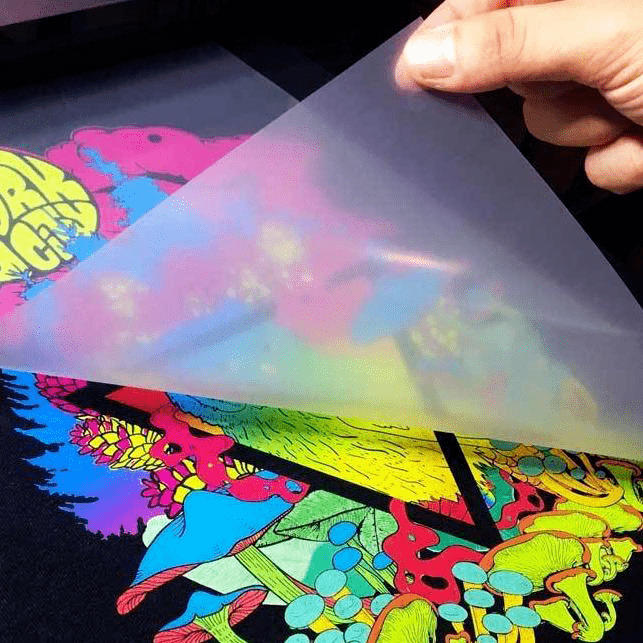Mastering DTF Printing: Idea for Achieving Vibrant and Durable Prints
Worldwide of textile printing, attaining long lasting and vivid prints is a sought after skill that can raise the quality of your output. Understanding DTF (Straight to Movie) printing requires a blend of technological knowledge, precision, and focus to information. From selecting the ideal products to tweak print setups and developing post-printing finishing methods, there are many factors that can influence the result of your prints. Recognizing just how to navigate these complexities can make all the distinction between a sub-par outcome and a genuinely extraordinary one.

DTF Printing Basics
For those brand-new to the globe of fabric printing, recognizing the basics of DTF printing is necessary to understanding this innovative technique. Direct to Movie (DTF) printing is a modern approach that entails moving designs from a special film onto various textiles making use of a warm press. Unlike conventional methods like display printing, DTF uses advantages such as vibrant shades, complex outlining, and the ability to print on varied products like cotton, polyester, and blends.
The process begins by publishing the style on a special DTF film using a compatible printer with CMYK or CMYKW ink collections. When the design is printed, it is then healed with a warmth press to develop a sturdy and resilient print. DTF printing is known for its capacity to recreate complex layouts with high accuracy and shade accuracy, making it a preferred selection for organizations seeking to produce customized apparel, marketing products, and much more.
Selecting the Right Materials

Equally essential is the choice of the sticky powder. The sticky powder works as a bonding agent between the printed design and the material, so it has to have strong bond buildings to ensure a long lasting and long-lasting transfer. Various materials might call for various sorts of sticky powders, so it is crucial to match the powder to the material kind for optimal results - DTF Printing. By carefully picking the ideal materials for DTF printing, printers can improve the top quality, vibrancy, and durability of their prints.
Optimizing Publish Settings
When aiming to achieve the ideal cause DTF printing, careful interest to optimizing print setups is essential for guaranteeing accurate and top quality transfers onto fabrics. When maximizing print settings is the resolution, one vital aspect to take into consideration. Higher resolutions typically cause dig this sharper and more in-depth prints, enhancing the total quality of the transfer. In addition, adjusting the ink thickness can assist attain lively colors and make certain that the style stands out on the material.
While increasing the rate can boost performance, it might jeopardize the final print's clearness and color saturation. Experimenting with different rates and observing the outcomes can aid establish the optimum setup for each print task.
In addition, make improvements shade accounts and making certain correct shade administration are important for accomplishing regular and precise colors throughout various prints. By calibrating shade setups and profiles, printers can reduce shade inconsistencies and generate uniform results, boosting the general print high quality and customer complete satisfaction.
Preparing Artwork for DTF Printing
Transform the art work to CMYK color mode to make certain that the colors convert accurately from screen to print. Bear in mind to mirror the final layout prior to printing to guarantee that it moves appropriately onto the garment. By following these actions and paying close focus to the details, you can prepare artwork that is enhanced for lively and sturdy DTF prints.
Post-Printing Finishing Techniques
Carrying out efficient post-printing ending up methods is important to improving the sturdiness and aesthetic charm of DTF prints on fabrics. Once the printing procedure is complete, using warm to the printed layout is crucial.
As soon as the movie is removed, the print might need added treating time to further establish the ink into the material. This step aids improve the washability and durability of the print, guaranteeing link it can withstand numerous wash cycles without fading or fracturing.
In addition, cutting any type of excess movie around the style can offer the final print a professional and clean look. Putting in the time to effectively finish DTF prints post-printing can significantly affect the total quality and durability of the fabric style.

Verdict
To conclude, grasping DTF printing calls for a complete understanding of the basics, picking suitable products, maximizing print setups, preparing artwork efficiently, and making use of post-printing finishing methods. By complying with these tips and techniques, one can accomplish resilient and visite site lively prints that meet their wanted high quality criteria. Consistent practice and interest to detail are vital in accomplishing effective results in DTF printing.
From picking the right products to adjust print setups and developing post-printing ending up strategies, there are countless variables that can affect the end result of your prints. Unlike standard techniques like screen printing, DTF supplies benefits such as lively colors, elaborate detailing, and the ability to print on varied products like cotton, polyester, and blends.
When the style is published, it is then healed with a warmth press to produce a long lasting and resilient print.When intending to accomplish the finest results in DTF printing, meticulous focus to enhancing print settings is important for making sure premium and precise transfers onto fabrics.In final thought, mastering DTF printing requires a thorough understanding of the essentials, choosing suitable products, maximizing print settings, preparing artwork properly, and using post-printing finishing strategies.
Comments on “A Deep Study DTF Printing: Methods, Advantages, and Market Applications”